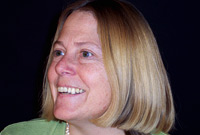Marvels of Modernism: Notes from the Curator
Alison Nordström, Curator of Photographs
George Eastman House, International Museum of Photography and Film
Modernism, when considered in the context of architecture and landscape architecture, is based on the interpretation of a particular site by considering functional requirements and the ways that chosen materials can best fulfill those needs.
When successful, the result is a seamless melding of a building and its surroundings that appears both singular and inevitable. In much the same way, the photographer, confronted with the assignment of rendering in two dimensions that which was built for peripatetic and physical experience in three, faces a similar challenge. The equivalents of functional requirements are the assignment itself and the content it dictates, as well as such vagaries as light, weather and points of access. Today especially, photographers also have a huge vocabulary of materials to choose among, including not only camera and lens, paper surfaces and printing possibilities, but the myriad decisions of format, cropping, color and other manipulation. The photographic component of Marvels of Modernism shows how photographers’ choices both shape and are shaped by the built landscapes they have been asked to depict. The techniques employed include such varied photographic technologies as ambrotype, pigment prints, and digital inkjet, and a variety of creative vignetting, framing and collage.
Marisol Díaz employs the conventions of straight photography to establish the apartment complex “El Monte” of Hato Rey, Puerto Rico in its tropical environment. Her careful composition balances the building with its designed landscape, and, while black and white may initially seem a counterintuitive choice for such rich and colorful surroundings, it provides no possibility for distraction from the formal concerns of both the structure and its depiction. In contrast, Tyagen Miller presents black and white photographs in round vignettes reminiscent of the earliest Kodaks or a glimpse through a keyhole into a secret garden. His unconventional treatment of otherwise ordinary space arrests us and invites hard looking. Heather Wetzel is perhaps the most surprising. Her choice of the ambrotype, a process past its heyday before the Civil War, to capture a Late Modern architectural style that would not manifest itself until 1967 injects a curious conflation of the near and distant pasts. Process notwithstanding, Wetzel’s work combines its clarity and materiality with the sensibility that Modernism today is itself somehow antique.
Sam Sweezy, Keri Pickett, Lupita Tinnen and Debra Bloomfield elect to produce the descriptive true color imagery characteristic of much architectural photography but also of contemporary photographic art. Sweezy adheres most strictly to Modernist conventions, employing compositions that emphasize the unornamented geometry and brutal functionalism of Boston City Hall Plaza. Pickett takes a similar stance in her treatment of Peavey Plaza in Minneapolis, though the people who use the park are foregrounded, in contrast to Sweezy’s nearly uninhabited landscape. Tinnen depicts Fort Worth’s Heritage Park a bereft of people and somewhat forlorn. The crepuscular shadows that dominate her images suggest the park’s current condition, abandoned by city government and closed to public access. Bloomfield, on the other hand, chooses against simple illustration of a site to manifest something that is both ambiguous and experiential. Her views of Estates Drive Reservoir in Oakland, California, suggest a distant site to be glimpsed through shrubbery and approached with a sense of delighted discovery. Her treatment of the Kaiser Roof Garden, also in Oakland, is similarly tantalizing. Like the New Topographics, these are in some sense pictures of nothing, that challenge the traditions of garden photography.
Rick Hock and Christopher Rauschenberg, working on opposite sides of the country, have chosen a technique of multi-image collage that feels both whimsical and free. Hock’s treatment of Rochester, New York’s Manhattan Square Park shows a complex site that can be simultaneously experienced from multiple points of view. His depiction of the spare geometry of Lawrence Halprin’s structure is further complicated by his inclusion of both professional murals and unplanned graffiti, firmly placing his images of Modernism in their post-Modern context of today. Similarly, Rauschenberg treats the distinctive white arches of Minoru Yamasaki’s Pacific Science Center Courtyard in Seattle as the mad fantasy that they are, his collage technique imparting an impression of idiosyncratic liveliness. Similarly, he chooses both collage and panorama to interpret Herbert Bayer’s Mill Creek Canyon Earthworks in Kent, Washington, creating an emphatically horizontal and multifaceted space as well as a sense of moving through it.
The aerial photographs of Tom Fox are, perhaps, in their own category, serving as a base-line foil for the more interpretive work. Despite allowances for light, angle and distance, they are map-like in their descriptive qualities, useful if one is planning an access road or a bombing run. They probably most resemble the landscape architect’s models, showing the land from a god-like perspective that obviates any notion of multi-sensual ambulatory engagement.
Because photographs so often look like truth, it is tempting to treat them as facts, and to judge photographic quality by an image’s ability to present large amounts of descriptive information. The purpose of conventional landscape photography is to illustrate a place, to show, as much as possible, what viewers would see if they visited a particular architectural example. This photography should disappear; the picture should replicate reality. This project, however, is as much about photography as it is about its subjects. The photographic choices made, in technique, vantage point and printing style, are clear and constitute a lesson both in seeing and in making something to be seen.



